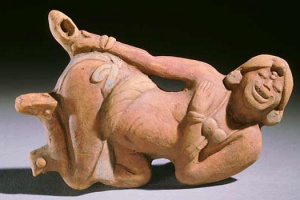December 30th, 2011 by John Mandrola, M.D. in Opinion, Research
1 Comment »

It is risky.
Stay fresh. Avoid repeating yourself. Don’t rant. Never preach. These would be the ‘rules’ of supposedly good blogs.
And, of course, doctors that dare to take a stance on health issues risk being perceived as pretentious. I get this.
So it is with trepidation that I write a follow-up to last week’s CW post about right ventricular damage immediately after an extreme race effort. Notwithstanding the pompousness concern, I also wish to avoid being labeled anti-exercise. Few believe more strongly in the healing powers of exercise.
But last Wednesday’s comments (both on the blog, Facebook and here on Dr. Val Jones’ BetterHealth blog) were just too good to let rest.
On the assessment of studies: Read more »
*This blog post was originally published at Dr John M*
December 13th, 2011 by Toni Brayer, M.D. in Research
No Comments »

 A study published in the journal Academic Pediatrics reveals that 93% of California children’s hospitals offered unhealthy food to outpatients, visitors and staff in the cafeteria and snack bars. Said another way, only 7% offered healthy food. What did these foods consist of to be called “unhealthy”? Try fried food, sweetened beverages, burgers and lots of sugary sweets.
A study published in the journal Academic Pediatrics reveals that 93% of California children’s hospitals offered unhealthy food to outpatients, visitors and staff in the cafeteria and snack bars. Said another way, only 7% offered healthy food. What did these foods consist of to be called “unhealthy”? Try fried food, sweetened beverages, burgers and lots of sugary sweets.
The study found that 81% of the cafeterias placed high-calorie, high-sugar items like ice cream right by the cash register, a well known marketing plan to tantalize and increase selection. Forty four percent didn’t even offer low calorie salad dressing and fewer than 1/3 had no nutrition information.
Health care workers, like the rest of America, suffer from increasing obesity. One study showed over 54% of Read more »
*This blog post was originally published at EverythingHealth*
November 25th, 2008 by Dr. Val Jones in Audio, Expert Interviews
7 Comments »

Photo Credit: authenticmaya.com
The blogosphere has been buzzing lately about the idea of “fecal transplants,” probably because this treatment (first studied in the 80’s) was recently mentioned on Grey’s Anatomy. Proponents of the therapy (which involves the introduction of donor stool into a patient via enema or naso-gastric tube) say that it can rejuvenate intestinal flora and cure c. diff colitis, and various inflammatory bowel disorders. I had my doubts about these claims and decided to interview gastroenterologist Dr. Brian Fennerty to get to the bottom (sorry abou the bad pun) of this issue.
Dr. Fennerty is a Professor of Medicine in the Division of Gastroenterology at Oregon Health & Science University in Portland, Oregon, where he also serves as Section Chief of Gastroenterology.
Listen to the podcast here:
[Audio:http://blog.getbetterhealth.com/wp-content/uploads/2008/11/brianfennertyfecallq.mp3]
Dr. Val: What exactly is a “fecal transplant?”
Dr. Fennerty: First, by way of background, you need to understand that the GI tract is populated with thousands of varieties of “good” bacteria that are essential for our health. If we didn’t have bacteria in our colon and small intestine, we would die. Fecal transplantation is the repopulation of a person’s gut bacteria (flora) with fecal matter from somebody else. Some argue that this helps to treat certain diseases.
Dr. Val: How is this procedure performed?
Dr. Fennerty: As it was originally described, fecal transplantation involved removing the undigested food particles from the stool sample of a “healthy” person, and then spinning it so that a pellet (of hundreds of thousands of species and quasi-species of bacteria) remains. The pellet is then introduced to the patient through a nasogastric tube into the small intestine, or the pellet can be resuspended in liquid and introduced into the rectum via an enema. The idea is that the bacteria will colonize the patient’s colon and squeeze out the bad bacteria that are in there.
Dr. Val: What are fecal transplants purported to do?
Read more »














